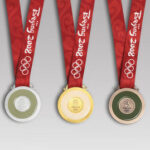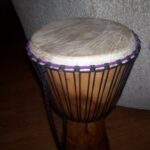SYNCOPATION: A rhythmic method drummers use to vary the position of stress on the beats so as to give the illusion of irregular rhythm. It can entail accenting weak beats and putting rests over strong beats, sudden time and/or meter changes, or simply playing a different rhythm from the rest of the band (in time with the band, of course).
“Progressive Steps to Syncopation for the Modern Drummer” was written by New York instructor Ted Reed out of necessity: There were no books on syncopation available in the 1950’s, and he had to write out each lesson by hand. He copyrighted his work and in 1958, had published what was to become one of the most popular teaching aids for drummers in the history of the art.
After the student learns the necessary prerequisites of timekeeping, reading drum charts (sheet music for drummers), and the basic snare rudiments, Ted Reed’s “Syncopation” helps the student master the tricky art of coordinating the bass drum foot with the hands that play the snare. Every example is played in standard 4/4 time, with the bass drum pounding out quarter note patterns steadily underneath.
The first lesson gets the drummer acquainted with quarter note technique. Each “Q” in the following example uses quarter notes. Each example in each lesson is four bars long (two are only shown for the sake of brevity). Be sure to alternate hands when performing snare strokes:
EXAMPLE 1
SNARE_____Q______Q______Q______Q__I
BASS ______Q______Q______Q______Q__I
Next in Lesson One, the drummer learns how to use quarter rests (“4”):
EXAMPLE 2
SNARE_____4______Q______Q______Q__ I
BASS ______Q_____ Q______Q______Q__ I
Next, half rests are employed on the snare (“2”):
EXAMPLE 3
SNARE_____2_____________Q______Q__I
BASS ______Q______Q_____ Q______Q__I
The quarter note variation continues throughout the lesson until all variations are exhausted. At the end of this lesson (and each of the lessons), there is a 16-bar exercise that mixes all the rhythmic variations of the lesson to help sharpen sight-reading as well as syncopation skills. Each subsequent lesson varies the quarter note patterns until Lesson Four, when eight notes “E” are introduced (as well as 20-bar exercises at the end of each lesson):
EXAMPLE 1
SNARE____E__E___Q______Q______Q__I
BASS _____Q______Q______Q______Q__I
EXAMPLE 7
SNARE___Q______Q______E__E__E__E_I
BASS ____Q______Q______Q_____Q____I
Lesson Five teaches dotted eight note (“E.”) and sixteenth note (“S”) technique:
EXAMPLE 14
SNARE___E.___S_Q______E.____S_Q__I
BASS ____Q_____ Q______Q______ Q__I
Lesson Six introduces the concept of triplets (“3”) to syncopation:
EXAMPLE 12
SNARE___3_3_3_Q______3_3_3_Q___I
BASS ____Q____ Q______ Q____ Q___I
Lesson Seven really gets interesting, when triplets and eight notes are mixed up:
EXAMPLE 14
SNARE___3_3_3_E__E___3_3_3_E__E__I
BASS____ Q____ Q______Q____ Q_____I
As each lesson progresses, the combination of snare notes and quarter-note bass drum patterns gets much more complex, helping the student master the art of syncopation one step at a time. As in mastering any other instrument, using a metronome is not just important, it is absolutely necessary for developing the “inner clock”. The inner clock is more important for drummers than any other musician, since it is they who set the tempo for the rest of the band. Start each lesson on a VERY SLOW tempo, and gradually increase the speed during each day’s practice during the week.
I have used this book to learn how to play, and I can tell you from experience, it is indispensible in learning coordination, and helping your limbs to operate independently. As each lesson is mastered, the student can add various embellishments to each example (such as adding a buzz roll or ghost stroke), employ the lessons using other drums and limbs (such as a hi-hat pattern against a snare, or one bass drum foot against the other), or simply flip them upside down, letting the snare keep the quarter-note beats while the bass drum foot works the snare patterns.
Perhaps the best thing about this book (list price: $7.95 – A BARGAIN!) is that it helps train the student’s ear to hear different rhythmic variations and techniques, thus helping him or her to more easily pick rhythms out of recorded music and better learn to “play by ear. This book lays a strong foundation for any future study of playing styles, from jazz to rock to afro-cuban.
Since 1958, this book has been reccomended by many great drummers and instructors of the modern age. Seriously, go into almost any music store, ask the clerk what he recommends for a drummer learning to play a drumset, and I am quite sure he will hand you a copy of Ted Reed’s “Syncopation. That’s how I got my copy, and I consider it the smartest investment I ever made!
Yeah, I may be a guitarist by trade, but learning to play the drums has made me a much better guitarist than I ever thought I’d be, and “Progressive Steps to Syncopation for the Modern Drummer” was a key part of my quest!




